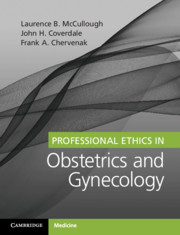Book contents
- Professional Ethics in Obstetrics and Gynecology
- Professional Ethics in Obstetrics and Gynecology
- Copyright page
- Dedication
- Contents
- Preface
- Acknowledgments
- Section 1 Professional Ethics in Obstetrics and Gynecology
- Section 2 Pedagogy of Professional Ethics in Obstetrics and Gynecology
- Section 3 Professionally Responsible Clinical Practice
- Chapter 7 Prevention of Pregnancy
- Chapter 8 Initiation of Pregnancy
- Chapter 9 Induced Abortion and Feticide
- Chapter 10 Fetal Analysis
- Chapter 11 Periviability
- Chapter 12 Intrapartum Management
- Chapter 13 The Perfect Baby
- Chapter 14 Cancer and Pregnancy
- Chapter 15 Setting Ethically Justified Limits on Life-Sustaining Treatment
- Section 4 Professionally Responsible Leadership
- Section 5 Professionally Responsible Innovation and Research
- Section 6 Professionally Responsible Health Policy and Advocacy
- Glossary of Key Concepts
- Index
- References
Chapter 7 - Prevention of Pregnancy
from Section 3 - Professionally Responsible Clinical Practice
Published online by Cambridge University Press: 01 November 2019
- Professional Ethics in Obstetrics and Gynecology
- Professional Ethics in Obstetrics and Gynecology
- Copyright page
- Dedication
- Contents
- Preface
- Acknowledgments
- Section 1 Professional Ethics in Obstetrics and Gynecology
- Section 2 Pedagogy of Professional Ethics in Obstetrics and Gynecology
- Section 3 Professionally Responsible Clinical Practice
- Chapter 7 Prevention of Pregnancy
- Chapter 8 Initiation of Pregnancy
- Chapter 9 Induced Abortion and Feticide
- Chapter 10 Fetal Analysis
- Chapter 11 Periviability
- Chapter 12 Intrapartum Management
- Chapter 13 The Perfect Baby
- Chapter 14 Cancer and Pregnancy
- Chapter 15 Setting Ethically Justified Limits on Life-Sustaining Treatment
- Section 4 Professionally Responsible Leadership
- Section 5 Professionally Responsible Innovation and Research
- Section 6 Professionally Responsible Health Policy and Advocacy
- Glossary of Key Concepts
- Index
- References
Summary
This chapter provides guidance on deliberative clinical judgment and decision making about preventing pregnancy in professional ethics in gynecology.
The biologic concept of sex is an essential component of the biologic concept of fertility. It is used to categorize human beings according to reproductive role: only the capacity to produce gametes, or the capacity to produce gametes and initiate a pregnancy. Sex was once thought to be dimorphic, but modern genomics of chromosomes has abandoned dimorphism for a concept of biologic sex as ranging along a continuum between these two productive roles. In other words, like all other human traits, biologic sex displays variation.
- Type
- Chapter
- Information
- Professional Ethics in Obstetrics and Gynecology , pp. 107 - 114Publisher: Cambridge University PressPrint publication year: 2019



